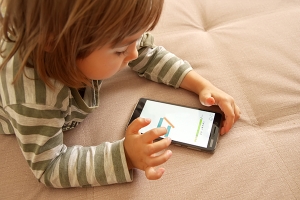
By now, most people know that kids spending too much time on screens is bad. According to the Mayo Clinic, potential dangers include behavioral issues, sleep problems, delays in language and social development, difficulty paying attention, violence and obesity. Many children also experience loneliness, anxiety or depression when screen time is excessive.
The problem with technology goes deeper than how kids are using it. The uncomfortable truth is that the amount of time parents spend on screens has a profound impact on kids, too. Excessive screen time by parents leads to distracted parenting, disengaged parent-child relationships and negative behavior in children—in other words, technoference.
What is technoference?
Technoference is a shortened term for “technology-based interference.” It refers to screen-focused behaviors that interfere with relationships—including those between parents and children. If you’ve found yourself ignoring your child in favor of technology (and inevitably noticed them doing the same to you), it’s time to make some changes. Other signs that technology is taking over include anxiety, poor sleep and feelings of isolation. If you’re experiencing [these things], you may be too involved in your phone, says Dr. Lori Whatley, a clinical psychologist specializing in the effects of digital device usage.
How does technoference impact children?
As parents spend more time on smartphones and electronic devices, kids work harder to gain their attention—often by misbehaving. According to Psychology Today, research demonstrates a relationship between the amount of technoference in a parent-child relationship and a child’s behavior (McDaniel & Radesky, 2018). To further complicate things, the more challenging a child’s behavior becomes, the more likely a parent will turn to their smartphone as a means of distraction or comfort.
“Screen use by parents impacts children negatively if it’s not in balance,” says Dr. Whatley. “Our kids need to know they matter and we prioritize them. If we are on digital devices and not making eye contact with them, their narrative becomes ‘I don’t matter.’” She explains that as a result, kids may begin to act out, seeking attention.
Making eye contact with children is imperative to their development. Eye contact helps develop emotional regulation and social skills, foster communication and build trust, among other things. Ask yourself, “How many times a day am I making eye contact with my kids?”
Children’s brains are unable to manage the stress of being ignored.
Kids do what they see parents do. “They are always watching us and mimicking our behavior,” says Dr. Whatley. “What we model is how they act.” If parents are spending a lot of time on screens, their kids probably are, too.
In her book, Connected & Engaged: How to Manage Digital Distractions and Reconnect with the World Around You, Dr. Whatley states: “We can and must help kids learn to let their phones be a tool to enhance their lives—not a prison that controls their lives.” To do this, parents should encourage kids to put phones away, get enough sleep, and meet friends in-person to establish deeper connections. Perhaps most importantly, parents need to model balanced, healthy behavior with technology.
Changing your family’s technology habits may be challenging, but it goes a long way towards improved mental health. Schools throughout California have started banning smartphones, but the biggest impact and influence on children is at home. To start, parents should establish and enforce age-appropriate screen time limits for kids, along with encouraging high-quality media content and co-participating whenever possible.
Tips to reduce technology use
According to Dr. Whatley, parents should teach kids that phones are a convenience, not something to which we are enslaved. The best way to do this is to model healthy behaviors. She provides three tips to reduce screen time usage:
- Don’t look at screens for the first hour of the day.
- Don’t look at screens for the last hour of each day.
- Put your phone away when you are with other people.
Additional methods include tracking usage, turning off message alerts and creating screen-free times (i.e. during mealtimes) and screen-free zones (bedrooms, cars and strollers). It may be helpful to create a family media plan; get help at www.sandiegofamily.com/parenting/big-kid/contracts-for-connected-families. Post it somewhere easily visible and offer rewards for compliance.
Schedule regular, offline, family fun time—preferably somewhere outdoors. Finally, be realistic with goals and stay on course. Change doesn’t occur overnight.
To learn more about the effects of parent media use on children from the Institute of Digital Media and Child Development, visit www.childrenandscreens.org/learn-explore/research/parent-media-use-technoference-and-its-effects-on-children-brandon-mcdaniel-phd.
A Note about Safety: What are kids doing on their devices?
If you don’t know the answer to this question for your own kids, it’s time to find out. Many parents express concerns about invading their child’s privacy, but the bigger (and more important) issue is protecting their safety and wellbeing. It is critical that parents monitor their children’s phones and devices. Kids need boundaries and safeguards.
Let your kids know you’ll be checking in—and remind them that a phone is not a journal for private thoughts and feelings. It’s actually a place where many others, including dangerous predators, have unrestricted access to kids.
Consider using parental controls or a monitoring service like Bark to scan for signs of harmful interactions and alarming content. Require your child to share all passwords to social media and messaging accounts. Scan their usage regularly.
Lisa Pawlak is an award-winning contributing writer who lives in Encinitas with her family.















